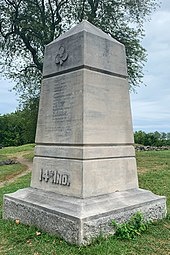14th Indiana Infantry Regiment
However, in response to Lincoln's call on May 3 for more than 42,000 troops to serve for three-year terms, the regiment reorganized for three years of service and mustered into the Union army on June 7, 1861.
[4] The regiment continued to serve in Virginia and Maryland from March to May 1862 in the 1st Brigade, 2nd Division, Army of the Potomac, and the Department of the Shenandoah.
[4] On December 12, the 14th Indiana was part of column of Union troops that attempted to storm the Confederates' fortified the breastworks under heavy artillery fire.
Unable to advance, the 14th Indiana reoccupied positions that General Sykes's division had once held and fortified them by constructing rifle pits and placing skirmishers in front of the breastworks.
Although the regiment was eventually driven back, its efforts delayed the Confederate advance, which allowed the Union's 11th and 12th Corps to restore its line.
On the evening of May 5, the regiment received orders to leave its position and return to the Rappahannock River, which the men had forded a few days earlier.
[10][note 3] The regiment took part in the Battle of Gettysburg (July 2–4, 1863), when Union General George Meade's Army of the Potomac defeated Confederate General Robert E. Lee's Army of Northern Virginia at Gettysburg, Pennsylvania, a small town intersected by numerous roads and surrounded by hills.
[20] On the morning of July 2, the 14th Indiana was deployed into position for an afternoon charge, and was sent to the front as relief troops to General Howard's 11th Corps late in the day.
The 14th Indiana was among those ordered to protect the exposed batteries at Cemetery Hill as part of the First Brigade, Hay's Division.
Colonel John Coons, commander of the regiment at Gettysburg, reported that the 14th Indiana initially supported Woodruff's battery near the center of the battle line in the morning.
With the 7th West Virginia and 4th Ohio Infantry, the 14th Indiana advanced with fixed bayonets, forming a line along a stone fence to defend Cemetery Hill.
[10][note 4] On July 3, the 14th Indiana remained with General Winfield Scott Hancock's 2nd Corps; however, the regiment was not involved in what became known as Pickett's Charge, when the Confederates assaulted the Union line and were repulsed several times before they finally retreated, ending the three-day battle.
Colonel Coons reported that the 14th Indiana engaged with the Confederates to the right of the cemetery all day on July 3, under heavy crossfire from artillery, but suffered few losses.
[note 5][22][23] When Lee's army retreated south, the 14th Indiana pursued the Confederate troops to Manassas Gap, Virginia.
[24] The riots were the result of the passage of the Enrollment Act in March 1863 that required men between the ages of 20 and 45 to register for the draft.
The U.S. Congress hoped that the laws would encourage enlistments in the Union army, but a legal loophole allowed draftees to pay a commutation fee of $300 or arrange for substitutes to serve in their place.
Civil unrest occurred at several sites around in the United States, but the draft riots in New York City caused more than a hundred deaths and the destruction of numerous buildings.
Local militias and federal troops, including the 14th Indiana, were called to New York City to help prevent further rioting.

